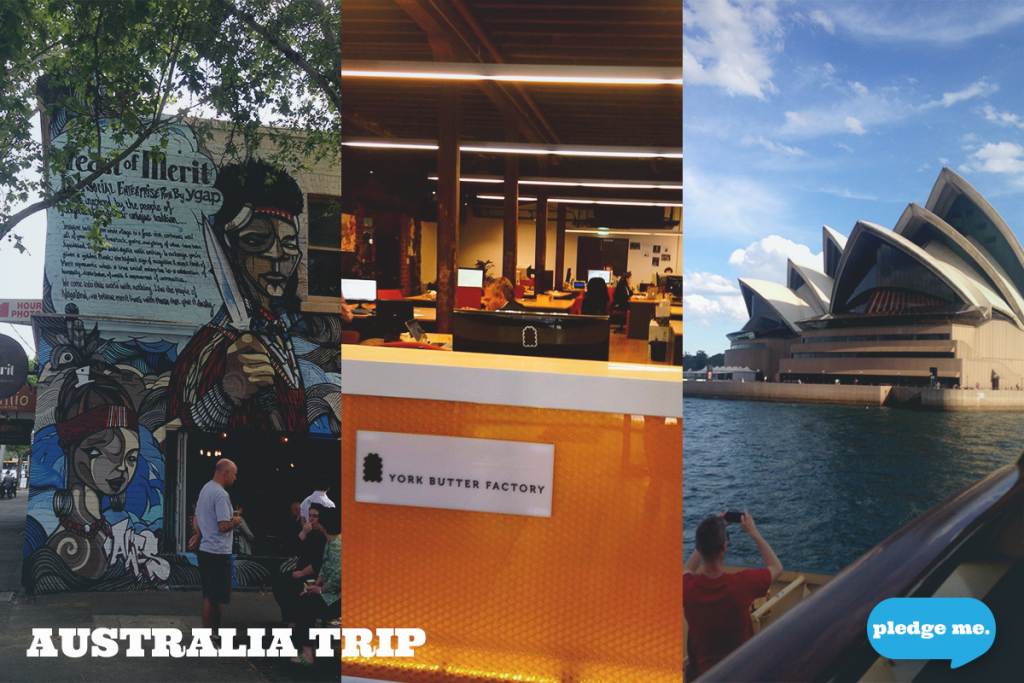Early last month, I spent two days in Melbourne and one day in Sydney meeting with local companies, co-working spaces, government, funders, and startup supporters.
My trip had two goals. Firstly to assess where Australia’s proposed legislation on equity crowdfunding was headed and secondly to get a sense (read sanity check) of whether PledgeMe should hop across the ditch.
Apart from realising that my American heritage felt strangely at home in the rule-focused country, here are my main findings:
Change of government is helping change the law
The Australian government has recently gone through a change of leadership (to the relief of most Australians it seems), and a shuffle of portfolios means there is a new minister in charge of the changes to their securities legislation. The Corporations and Markets Advisory Committee (CAMAC) which wrote the original report around equity crowdfunding has been abolished, leaving Australia with the mouthful of a moniker “crowd sourced equity funding” for equity crowdfunding. Now, after two rounds of submissions, the equity piece is slated to enter the innovation statement set to come out by December 2015.
There is a general sense of optimism around the changes. The new Prime Minister, Malcolm Turnbull, has a background in tech. This seems to leading the industry to believe he will make changes to support SMEs. He’s already shown he is capable of doing this with recent employee share scheme changes.
“We believe that government’s role is not to tell citizens, let alone businesses, what is best, but rather to enable them to do their best.” Malcolm Turnbull
However, many predict Australia is more likely to follow the American way of equity crowdfunding. People I spoke to said as much: “Australians like rules”. This means there will probably be investor caps on how much individual investors can invest, both per campaign and per year. This stems, in part, from a general fear from institutional investors that retail investors would lose all their money in this space. New Zealand originally discussed investor caps, but decided not to go down that path. We agree with this. Caps on investment assume that retail investors need protection from themselves. This could be seen as somewhat patronising and counter to Prime Minister Turnbull’s above statement.
There has been some talk recently about the law change excluding debt/peer-to-peer(P2P), and existing only for public companies. Both of these comments are strange, for the following reasons:
P2P
Debt crowdfunding, crowdlending, peer-to-peer, whatever you call it, is two thirds of the international crowdfunding market. Yep, bigger than all the equity crowdfunding and kickstarter-esque platforms combined. So it seems odd that it’s being left out of the conversation. In fact, in New Zealand, equity crowdfunding was actually an afterthought added after one of the P2P platforms made a side comment about it in a meeting in the lead up to our legislation changes. And, it’s a space that we’re really interested in ourselves as it helps more than just companies find funding – it supports individuals, other organisational set up, and social enterprises. So interested in fact, that we’re exploring an SME / organisational product for kiwis.
There are P2P platforms operating already in Australia, but under the old legislation with high compliance costs.
Public companies
Company structures in Australia are different to New Zealand.
In New Zealand, the companies coming through are private companies. They are not tied to the same continuous disclosures that a public company would be required to do, and are not required to create a public prospectus for funding. While equity crowdfunding may trigger the Takeovers Code (eg. a company has more than 50 voting shareholders) and a company may be required to audit their financials if their voting shareholders do not opt out, these companies are not classified as public.
In Australia, if you have more than 50 non-employee shareholders, you immediately move from being a proprietary (or private) company to being a public company (albeit unlisted). This means you are required to have 3 directors (2 need to be Australians) and are required to provide a directors statement, financials and an auditor’s report annually.
There is a need for funding (and a crowd)
Australia is seeing more Venture Capital funds coming through for tech, a maturing startup ecosystem, and a growth in impact investment. But, there was also a general sense that while Australia is generally wealthy, it is more likely to go into traditional investments (eg. asset classes), not currently into start ups. Also, Basel III has made it harder for SME’s to access bank loans. But there are some companies that need growth funding that aren’t supported by the current ecosystem, with 10% of Australian SME’s stating they have difficulty accessing capital to grow in a recent Deloitte report. Often, these companies either wouldn’t fall in the traditional investment space or would not choose to go down the traditional investment route.
My conversations made me realise that the other side of crowdfunding (the crowd) had been seriously downplayed in the discussions around legislation changes. Everyone was hung up on the funding (and potential to lose money) and overlooked the other skills, support, and insight a crowd of consumer investors could bring.
I told the story of Brianne from Sorbet pretty much on repeat. How she went out and raised $200k from her crowd in two weeks, but not only did she get cash from her crowd; she also had three chemists invest. There was a problem she’d been working on for weeks if not months, which they came in and fixed in half an hour.
It’s a big (and complicated) market
Australia is large compared to New Zealand. With five times the population, there is more individual wealth (one person ball parked 10x that of NZ), and there are more layers to bureaucracy (city, state, federal).
There was a comment that Australia is more likely to back Australian owned, and that we would need distinctive entry plans tailored to each city. Which really made us think that if we wanted to go to Australia, we’d need partners. Companies or organisations that reflect our values, but aren’t already in the crowdfunding space.
It’s a crowded market
There are quite a few players getting ready to launch in the space. Some platforms have already completed their technical development, and there is a sense of waiting to see how the legislation lands.
Some platforms believe the changes could come through this year (as stated in one of the documents released by government) where others think it will still be at least 6 months before the first platform is licensed and launching campaigns.
There are a range of platforms getting ready to enter the space, some with project based crowdfunding experience, some currently in the equity crowdfunding space in NZ (Equitise, My Angel Invest) and some specific niche crowdfunders (all the property….).
Where to from here?
I feel like there is little sense for PledgeMe to try and enter the Australian market on its own. But, we are open to partnering with companies in Australia to set up a platform (with us bringing the tech / expertise, and a partner bringing the potential base of campaign creators / presence / brand recognition). Partnering would be a stronger proposition than setting up a new platform from scratch.
So if there are any folk that would like to continue conversations or start conversations, get in touch with me (anna@pledgeme.co.nz). We’re keen to support the democratisation of funding in Australia, and are actively waiting to see how the final legislation pans out.
Final thought
For all that’s good Australia, please don’t go down the path of over regulation. If you write 635 pages of guidance for platforms like the USA, you’ve already stifled the innovation of your 140 character fueled future.
And…
a big thanks to everyone that took the time to meet with me and share their thoughts on the future of funding in Australia.




